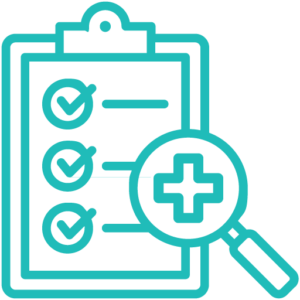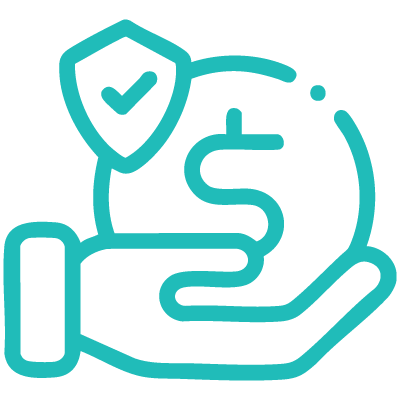DIME PROJECT

Building healthcare around the patient, not the clinic

Program evaluation & reimbursement pathways
This section demonstrates hospital-at-home (HaH) value—from tracking program performance and proving ROI to securing sustainable reimbursement across diverse payor types. It includes specific measures, target audiences, and actionable insights backed by real-world evidence. Use these tools to align your measurement efforts with strategic goals, engage key stakeholders, and establish the financial foundation your HaH program needs to thrive beyond current waiver limitations.

Why measurement matters
Measurement is essential for demonstrating the value and impact of HaH. Use this table to align your measurement efforts with strategic goals, engage key stakeholders, and secure the financial foundation for your HaH program.
-
Track HaH program performance
 Enables continuous program improvement through management and oversight
Enables continuous program improvement through management and oversightPRIMARY AUDIENCE: Health system clinical, operational, and executive leadership; payors, policymakers, and ecosystem partners
KEY QUESTIONS
- Is the program meeting quality, safety, and experience goals?
- How efficiently and effectively is the program operating?
- What are key opportunities for program improvement?
CATEGORIES OF MEASURES
- Clinical, quality, & safety outcomes
- Operational performance & efficiency
- Access, equity, & experience
- Cost & resource utilization
Click measure of interest to dive deeper.
-
Demonstrate ROI

Demonstrates HaH’s financial viability and overall value to secure ongoing investment
PRIMARY AUDIENCE: Health system clinical, operational, executiveHealth system executive, financial, and administrative leadership
KEY QUESTIONS
- Does the program generate positive financial ROI?
- What factors drive the program’s value?
- Do the combined financial returns and patient outcomes justify the investment and operational costs?
CATEGORIES OF MEASURES
- Cost & resource utilization
- Clinical, quality, & safety outcomes
- Access, equity, & experience
- Operational performance & efficiency
Click measure of interest to dive deeper.
-
Compare HaH to traditional cost of care
 Highlights opportunities for cost comparison that support adopting HaH
Highlights opportunities for cost comparison that support adopting HaHPRIMARY AUDIENCE: Financial and strategic leaders representing payors, health systems, and policymakers
KEY QUESTIONS
- What is the difference in cost between facility-based acute care and HaH?
- Do specific cost savings occur in HaH programs?
- How do fixed and variable costs differ for HaH?
- How do cost differences impact stakeholders’ spending?
CATEGORIES OF MEASURES
Click measure of interest to dive deeper.
-
Drive payor adoption
 Justifies coverage by demonstrating HaH’s value proposition to payors for broad member access
Justifies coverage by demonstrating HaH’s value proposition to payors for broad member accessPRIMARY AUDIENCE: Strategic and contracting leaders representing payors, health systems, and policymakers
KEY QUESTIONS
- Does the evidence for HaH support its inclusion as a standard health plan benefit
- What are the key considerations for HaH coverage on a fee-for-service (FFS), bundled payment, risk arrangement, or per diem basis?
CATEGORIES OF MEASURES
- Clinical, quality, & safety outcomes
- Access, equity, & experience
- Cost & resource utilization
- Operational performance & efficiency
Click measure of interest to dive deeper.
-
Promote value-based care (VBC) integration
 Establishes HaH’s compatibility with VBC models that reward value over volume
Establishes HaH’s compatibility with VBC models that reward value over volumePRIMARY AUDIENCE: Payment reform leaders representing payors, health systems, and policymakers
KEY QUESTIONS
- How does HaH help achieve specific VBC goals for value (cost and quality)?
- How does HaH performance align with common VBC models?
- What payment structures best support HaH integration within different VBC models?
CATEGORIES OF MEASURES
- Cost & resource utilization
- Clinical, quality, & safety outcomes
- Access, equity, & experience
- Operational performance & efficiency
Click measure of interest to dive deeper.
Key measures for evaluating the value and impact of HaH
Each table includes a working description of measures in the HaH context and concise insights drawn from high-quality evidence to support program evaluation, ROI analysis, payor engagement, and value-based care (VBC) integration. Users should interpret these insights with an awareness of key contextual variables, namely geographic differences (e.g., US vs. international, rural vs. urban), as well as evolving terminology (e.g., “transfer” vs. “discharge” under the CMS waiver), varying patient populations and clinical conditions, and the lack of standardization in how outcomes are defined and reported in the literature. These nuances are critical for aligning measurement with your specific program goals and building a compelling, context-aware HaH value framework.
| Measure | Description | Insights |
|---|---|---|
|
Measure:
All-cause mortality (ACM) |
Description:
Total deaths from any cause during a specified time frame. Offers insights into HaH’s safety and effectiveness. |
Insights:
CMS data and Cochrane reviews(1,2) show HaH is at least as safe as inpatient care, with some evidence of lower mortality in certain models and clinical conditions. |
|
Measure:
Unanticipated mortality |
Description:
Deaths during home or post-escalation inpatient care, excluding hospice or expected cases. Reflects safety events that may require further evaluation. |
Insights:
CMS data shows very low rates (0.24%), reinforcing the safety of robust HaH patient selection and care protocols. CMS requires reporting on unanticipated mortality to support program evaluation and continuous quality improvement. |
|
Measure:
Adverse drug events (ADEs) |
Description:
Harm from medications, such as overdoses or allergic reactions. Evaluates the safety of medication management in HaH. |
Insights:
A case study from Mount Sinai suggests HaH ADEs are non-severe and stem from patient/caregiver administration errors or unintentional non-adherence, highlighting the importance of medication safety protocols in HaH programs. |
|
Measure:
Hospital-acquired conditions (HACs) |
Description:
Conditions like falls or pressure ulcers acquired during hospitalization. Demonstrates HaH’s ability to prevent hospital-acquired complications. |
Insights:
CMS data reports HaH programs show similar or lower rates of specific hospital-acquired conditions (e.g., falls and pressure ulcers) when compared to inpatient care. |
|
Measure:
Hospital-associated infections (HAIs) |
Description:
Infections acquired during hospitalization, such as urinary tract infections (UTIs) or pneumonia. Assesses HaH’s effectiveness in preventing infections. |
Insights:
CMS data and a Cochrane review reported rates of HAI’s (e.g., UTI and pneumonia) similar or lower in HaH compared to inpatient care, though differences were not statistically significant due to small sample sizes and study variability. |
|
Measure:
Technology failure resulting in harm |
Description:
Harm from technology or equipment failures. Evaluates HaH’s reliability and safety in delivering care. |
Insights:
This ERCI report emphasizes the importance of user-friendly technology, clear cleaning protocols, robust AI governance, and effective cybersecurity measures to ensure reliable healthcare at home. |
| Measure | Description | Insights |
|---|---|---|
|
Measure:
Equitable access to care |
Description:
Distribution of HaH services across demographics (e.g., race, income, language, insurance status). Assesses whether HaH is reaching all patients equitably. |
Insights:
CMS data describes higher participation among white, urban, and non-Medicaid patients, noting how program selection criteria (e.g., home environment and psychosocial factors) may limit equitable access to HaH care. |
|
Measure:
Days at home |
Description:
Total number of days patients remain at home during their care episode. Highlights how well HaH supports keeping patients out of hospitals. |
Insights:
Evidence consistently shows that HaH programs, particularly early supported discharge models, reduce the number of days patients spend within the physical hospital compared to traditional inpatient care. |
|
Measure:
Patient experience |
Description:
Patient feedback on their care experience, including shared decision-making and overall care coordination. Essential for monitoring patient-centered care. |
Insights:
CMS collected anecdotal information during the AHCAH initiative, suggesting positive patient and care partner experiences, aligning with meta-analyses summarized by Providence and evidence more broadly, showing higher satisfaction with HaH vs inpatient care. Survey data highlights differences driven by increased comfort, communication, and family involvement. |
|
Measure:
Caregiver impact and well-being |
Description:
Impact of being a caregiver in HaH. Tracking through HCAHPS or similar tools highlights the effects of HaH on caregivers. |
Insights:
Research summarized by Providence shows HaH impact on caregivers is comparable to or less than inpatient care when tailored support is provided, offset by assessing caregiver capacity and budgeting for support. |
|
Measure:
Provider and staff experience |
Description:
Feedback from HaH workforce on workload, job satisfaction, and operational support. Informs workforce sustainability and system performance. |
Insights:
A Brigham and Women’s study found HaH staff reported high job satisfaction (median 4.5/5) with 88% reporting no symptoms of burnout (e.g., emotional exhaustion and reduced sense of professional accomplishment). |
|
Measure:
Digital access and usability |
Description:
Ease with which patients and care partners can use digital health technologies (DHTs) for care at home. Tracking access and usability is critical for remote care delivery. |
Insights:
A scoping review in Frontiers highlights that addressing digital usability and access disparities requires investment in infrastructure and technical support to ensure all patients can benefit from digital care. |
| Measure | Description | Insights |
|---|---|---|
|
Measure:
Length of stay (LOS) |
Description:
Total number of days a patient remains under HaH care. Supports analysis of HaH resource use and efficiency. |
Insights:
A Cochrane review reports that admission avoidance HaH models reduce initial hospital days, shorten total hospital LOS, and improve throughput compared to inpatient care. When post-acute home care is included, the overall HaH episode may last longer than a traditional inpatient stay. |
|
Measure:
Total cost of care |
Description:
Comprehensive cost associated with a patient’s care in HaH. Reveals cost-effectiveness and resource differences across settings. |
Insights:
Randomized controlled trial data show HaH can reduce direct care costs and resource use. An Atrium Health case study reports 20% lower costs for HaH vs brick-and-mortar care delivery. CMS notes inconclusive results attributable to AHCAH patient selection criteria and clinical complexity. |
|
Measure:
Episode-level savings |
Description:
Difference in cost between HaH and equivalent inpatient care episodes. Provides insight into potential cost savings at the episode level of HaH. |
Insights:
In a randomized controlled trial, the adjusted mean cost of the acute care episode was 38% lower for HaH patients than inpatients, related to fewer lab orders, imaging studies, and clinical consultations. |
|
Measure:
Fixed costs of HaH program |
Description:
Ongoing operational expenses such as staffing, logistics, and technology. Assesses HaH’s financial sustainability and scalability. |
Insights:
NEJM CareerCenter notes HaH programs should invest in infrastructure (e.g., command center staffing and technology platforms) and logistics (e.g., transportation), to coordinate care delivery and integrate with inpatient services. |
|
Measure:
Bed days saved |
Description:
Number of hospital inpatient days avoided by providing acute care at home. Highlights HaH’s potential to alleviate inpatient capacity constraints. |
Insights:
An Atrium Health case study reports saving nearly 30,000 bed days in the first three years of the North Carolina-based HaH program, freeing up inpatient beds for those in need, and accounting for 2% of total beds in the region. |
|
Measure:
Skilled nursing facility (SNF) referrals |
Description:
Number of patients referred to SNFs for post-acute care. Assesses HaH’s effect on post-acute institutional resource use. |
Insights:
Mass General Brigham reports HaH patients are less likely to be discharged to SNFs and more likely to recover at home, resulting in lower post-acute institutional care and spending compared to inpatient hospitalization. |
|
Measure:
Readmission rates |
Description:
Percentage of patients readmitted post-HaH discharge. Evaluates HaH’s effectiveness in minimizing costly hospitalizations. |
| Measure | Description | Insights |
|---|---|---|
|
Measure:
Census |
Description:
Total number of patients enrolled in the HaH program at a given time. Informs planning and workforce allocation based on available capacity. |
Insights:
Data from a US cohort study shows initial census can be modest and variable, necessitating robust strategies for HaH program growth to address barriers, including clinical eligibility, insurance coverage, and patient preference. |
|
Measure:
Patient volume |
Description:
Total number of patients served by HaH over a defined time period, including multiple discharges of the same patient. Evaluates HaH program throughput. |
Insights:
MedPAC found AHCAH hospitals had higher all-payor patient volume, suggesting HaH integration was a strategic extension of care. CMS requires reporting on patient volume to support program evaluation and continuous quality improvement. |
|
Measure:
Referral volume and time from referral to admission |
Description:
Number of patient referrals, time, and time elapsed between referral and HaH admission. Assesses awareness and demand, guides resource planning, and evaluates responsiveness. |
Insights:
Study data shows referrals may not consistently lead to enrollment, and for ~50% of enrollments, admission occurs after the first day, highlighting the importance of tracking referral sources and navigating CMS in-person evaluation requirements. |
|
Measure:
Visit adherence |
Description:
Percentage of scheduled visits completed as planned by patients and providers. Evaluates program reliability and operational consistency. |
Insights:
CMS requires at least two in-person HaH visits daily, including a minimum of two sets of in-person vitals. Adherence to requirements may be challenging due to scheduling conflicts, travel demands, and staff absences. |
|
Measure:
Escalation rate (emergency department (ED) visits and transfers to inpatient care) |
Description:
Number of ED visits or transfers to inpatient care from HaH, including for patient preference but not planned diagnostic testing or treatment. Monitors the ability to manage patient care in the home. |
Insights:
Reviews and reports lack evidence of higher rates of ED visits or transfers to inpatient care from HaH, attributed to robust patient selection, remote monitoring, and rapid response systems. CMS requires reporting on escalation rate to support program evaluation and continuous quality improvement. |
|
Measure:
Response time |
Description:
Time to respond to clinical escalations in the home setting, including in-person rapid response and immediate remote access. Assesses operational responsiveness in HaH. |
Insights:
Evidence on average response times in HaH settings is limited, but CMS requires immediate remote evaluation and in-person response within 30 minutes for acute-level programs. Post-acute HaH data from Mayo Clinic shows promising signals with >80% of escalation events managed by rapid response teams at home. |
|
Measure:
Provider and staff workload |
Description:
Amount of work performed by HaH staff, including patient volume, visit frequency, documentation, and travel. Assesses staffing needs and efficiency with insight into potential risks for burnout. |
Insights:
According to the results of this systematic review, patient characteristics, including male sex, older age, worse functional status, a greater number of diagnoses, and a rural environment, are independent predictors of HaH workload. |
Pathways to sustainable reimbursement
Securing sustainable reimbursement is vital for the long-term success of HaH programs. The HaH payment pathways presented include both established and emerging models. Widespread payor adoption, including value-based care (VBC) contracting, continues to develop and shape the future of sustainable reimbursement for HaH beyond current CMS waiver flexibilities.
The resource below covers traditional CMS and Medicare programs, including the Acute Hospital Care at Home (AHCAH) waiver, Medicare Advantage (MA) opportunities, state-specific Medicaid approaches, commercial and employer strategies, and broader Value-Based Care (VBC) contracting initiatives. Tracking performance, demonstrating ROI, comparing costs, driving payor adoption, and promoting VBC integration directly support the payment pathways below. For example, your cost comparison data becomes essential evidence when negotiating MA contracts, while your ROI metrics help secure direct employer agreements. Use the tables to navigate forward-looking pathways for each payor type and build a strong financial foundation for the future of your HaH program.
For dual-eligible patients, effective HaH programs must align Medicare benefits (AHCAH waiver, Part B, Dual Eligible Special Needs plan – DSNP) with applicable state-specific Medicaid coverage for seamless, coordinated care.
| Payment approach | How it applies to HaH | Actions required | Financial considerations |
|---|---|---|---|
|
Payment approach:
CMS Acute Hospital Care at Home (AHCAH) waiver program |
How it applies to HaH:
Allows approved hospitals to bill traditional Medicare FFS for providing acute care in the home using standard MS-DRG payments. |
Actions required:
|
Financial considerations:
|
|
Payment approach:
Medicare Part B professional service fees |
How it applies to HaH:
Physicians and other Qualified Healthcare Professionals (QHPs) bill Medicare Part B for professional services (e.g., visits, telehealth, care management) provided to HaH patients. |
Actions required:
|
Financial considerations:
|
Federal support for HaH, including via extension to the CMS AHCAH waiver, is a critical enabler for Medicare Advantage (MA) plans to offer coverage. For an industry example, review this resource from UnitedHealthcare regarding HaH as a covered benefit under MA plans.
| Payment approach | How it applies to HaH | Actions required | Financial considerations |
|---|---|---|---|
|
Payment approach:
Negotiated contract rates (e.g., per diem, case rates) |
How it applies to HaH:
MA plan and provider directly negotiate HaH service payments, such per diem (amount per day) or case rates (amount per episode), outside of standard Medicare fee-for-service DRGs. |
Actions required
:
|
Financial considerations:
|
|
Payment approach:
In-network provider agreements |
How it applies to HaH:
HaH program becomes a contracted, in-network provider for a MA plan. The agreement specifies terms, conditions, and payment structure for delivering HaH services. |
Actions required
:
|
Financial considerations:
|
|
Payment approach:
Plan-offered supplemental benefits |
How it applies to HaH:
MA plan includes HaH as a supplemental benefit to attract members as a general health benefit or provide enhanced care for specific populations. |
Actions required
:
|
Financial considerations:
|
Multiple states have provided Medicaid coverage of HaH, including AZ, AR, FL, MA, MI, NY, NC, OK, OR, SC, SD, and TX. As coverage is linked to the CMS AHCAH waiver and evolving legislation, seek state-specific Medicaid guidance for up-to-date coverage confirmation.
| Payment approach | How it applies to HaH | Actions required | Financial considerations |
|---|---|---|---|
|
Payment approach:
CMS Acute Hospital Care at Home (AHCAH) waiver program |
How it applies to HaH:
State Medicaid fee-for-service (FFS) programs align with federal AHCAH waiver terms, enabling approved hospitals to bill for inpatient-level acute care at home for non-managed care organization (MCO) Medicaid beneficiaries using MS-DRG payment principles. |
Actions required:
|
Financial considerations:
|
|
Payment approach:
Managed care organization (MCO) contracts |
How it applies to HaH:
HaH provider contracts directly with Medicaid MCOs to deliver acute care services. MCOs fund this via state capitated payments, with flexible payment designs (e.g., per diem, case rates, FFS-like or value-based elements). |
Actions required:
|
Financial considerations:
|
|
Payment approach:
State plan amendments (SPAs) |
How it applies to HaH:
A state defines HaH as a covered Medicaid FFS benefit via a CMS-approved State Plan Amendment (SPA), detailing service scope, provider qualifications, patient eligibility, and reimbursement. This approval process can be lengthy. |
Actions required:
|
Financial considerations:
|
|
Payment approach:
Section (§) 1115 waiver flexibilities |
How it applies to HaH:
A state obtains a CMS-approved §1115 research and demonstration waiver to pilot innovative HaH programs, testing new approaches to service delivery, eligibility, and payment for HaH (often with specific funding or global budget arrangements) outside standard Medicaid rules. |
Actions required:
|
Financial considerations:
|
| Payment approach | How it applies to HaH | Actions required | Financial considerations |
|---|---|---|---|
|
Payment approach:
Negotiated in-network rates (e.g., fee-for-service, per-diem, case rates) |
How it applies to HaH:
HaH provider contracts with commercial health plans, negotiating payment for services to members via discounted fee-for-service (FFS), per diem, or case rates for defined episodes. |
Actions required:
|
Financial considerations:
|
|
Payment approach:
Direct-to-employer (self-insured) contracts |
How it applies to HaH:
HaH provider contracts directly with self-insured employers to offer HaH services to employees and dependents, aiming to reduce total healthcare spend and improve employee well-being. |
Actions required:
|
Financial considerations:
|
|
Payment approach:
Third-party administrator (TPA) network agreements |
How it applies to HaH:
HaH provider contracts with TPAs, making their services available to employees of the various self-insured employers those TPAs manage. |
Actions required:
|
Financial considerations:
|
| Payment approach | How it applies to HaH | Typical payors | Actions required | Financial considerations |
|---|---|---|---|---|
|
Payment approach:
Bundled payments for HaH episodes |
How it applies to HaH:
A single, comprehensive payment covers all services for a HaH clinical episode over a defined period. |
Typical payors:
|
Actions required:
|
Financial considerations:
|
|
Payment approach:
Population-based payments / per member per month (PMPM) |
How it applies to HaH:
Provider receives a fixed monthly payment for member health management, strategically using HaH for acute needs. |
Typical payors:
|
Actions required:
|
Financial considerations:
|
|
Payment approach:
Shared savings programs (e.g., Accountable Care Organizations – ACOs) |
How it applies to HaH:
HaH allows ACOs to achieve shared savings goals through care coordination and reducing avoidable inpatient costs. |
Typical payors:
|
Actions required:
|
Financial considerations:
|
|
Payment approach:
Pay-for-performance (P4P) |
How it applies to HaH:
HaH providers earn bonuses for meeting performance targets, contributing to quality and efficiency scores. |
Typical payors:
|
Actions required:
|
Financial considerations:
|
|
Payment approach:
Condition-specific capitation / Advanced case rates |
How it applies to HaH:
Fixed payment for managing specific, eligible conditions (e.g., congestive heart failure – CHF, chronic obstructive pulmonary disease – COPD) via HaH. |
Typical payors:
|
Actions required:
|
Financial considerations:
|
Hospitals approved via the CMS waiver pathways are required to submit monitoring data for specific reporting measures (patient volume, unanticipated mortality, and escalation rate) on a weekly or monthly basis. Review the official requirements and specific pathway details on the CMS QualityNet webpage.



